 W
WSir Andrew Smith KCB was a Scottish surgeon, explorer, ethnologist and zoologist. He is considered the father of zoology in South Africa having described many species across a wide range of groups in his major work, Illustrations of the Zoology of South Africa.
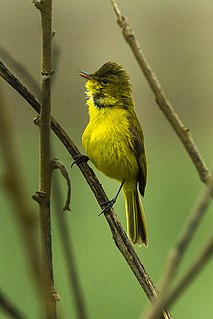 W
WThe African yellow warbler, Natal yellow warbler, dark-capped yellow warbler, or yellow flycatcher-warbler is a species of Acrocephalidae warblers; formerly, these were placed in the paraphyletic "Old World warblers".
 W
WThe Angolan free-tailed bat is a species of bat in the family Molossidae. It is found in Angola, Benin, Botswana, Burkina Faso, Burundi, Cameroon, the Republic of the Congo, the Democratic Republic of the Congo, Ivory Coast, Ethiopia, Gambia, Ghana, Guinea, Kenya, Malawi, Mali, Mozambique, Namibia, Niger, Nigeria, Rwanda, Senegal, Sierra Leone, Somalia, South Africa, South Sudan, Sudan, Swaziland, Tanzania, Togo, Uganda, Zambia, and Zimbabwe. Its natural habitats are dry and moist savanna, although it is sometimes found at the edges of woodlands.
 W
WAparallactus is a genus of rear-fanged venomous snakes found in Africa. Currently, 11 species are recognized.
 W
WArthroleptis is a genus of frogs in the family Arthroleptidae found in tropical sub-Saharan Africa. Their common names include screeching frogs, sometimes simply squeakers.
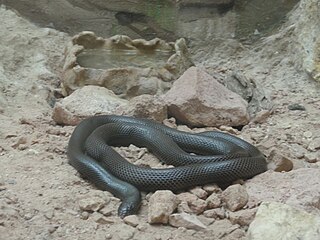 W
WAtractaspis is a genus of venomous snakes in the family Lamprophiidae. The genus is endemic to Africa and the Middle East. The genus contains 15 species that are recognized by ITIS. Others recognize as many as 21 species. 23 are listed here.
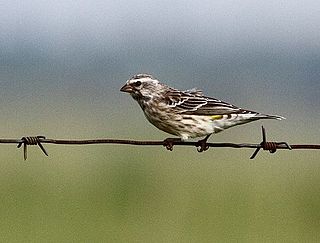 W
WThe black-throated canary, also known as the black-throated seedeater, is a species of finch in the family Fringillidae.
 W
WBrants's whistling rat or Brants' whistling rat is one of two species of murid rodent in the genus Parotomys. It is found in Botswana, Namibia, and South Africa where its natural habitats are subtropical or tropical dry shrubland and pastureland. It was first described in 1834 by the Scottish zoologist Andrew Smith who named it in honour of the Dutch zoologist and author Anton Brants.
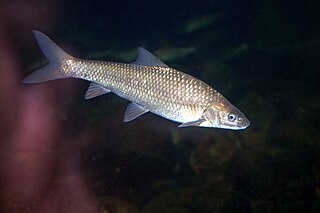 W
WThe Cape whitefish or Berg-breede River whitefish is a ray-finned fish species in the family Cyprinidae. It is placed with the South African redfins in Pseudobarbus. It is tetraploid. Its closest living relative was at one time considered the sawfin.
 W
WCarcharodon is a genus of sharks within the family Lamnidae. The only extant member of the genus is the great white shark. Extinct members of the genus include Carcharodon caifassii and Carcharodon hubbelli. Otodus megalodon is still argued by some paleontologists to be a close relative of Carcharodon carcharias. The megalodon's scientific name was originally 'Carcharodon' megalodon, but more recently, the giant shark has been assigned by most scientists to the genus Carcharocles.
 W
WDasypeltis is a genus of colubrid snakes. It is one of only two taxonomic groups of snakes known to have adapted to feed exclusively on eggs. Dasypeltis are non-venomous and found throughout the continent of Africa, primarily in forested or wooded habitats that are also home to numerous species of birds.
 W
WMice in the genus Dendromus are commonly referred to as African climbing mice or tree mice, although these terms are often used to describe all members of the subfamily Dendromurinae. The genus is currently restricted to sub-Saharan Africa, but fossils classified in the genus have been found from Late Miocene deposits in Arabia and Europe.
 W
WThe black-chested snake eagle or black-breasted snake eagle is a large African bird of prey of the family Accipitridae. It resembles other snake eagles and was formerly considered conspecific with the short-toed and Beaudouin's snake eagles, to which it is closely related.
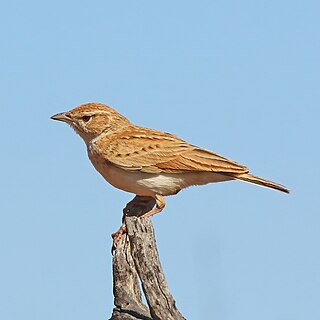 W
WThe fawn-coloured lark or fawn-coloured bush-lark is a species of lark in the family Alaudidae. It is found in south-central Africa.
 W
WThe subgenus Geosciurus of African ground squirrels are found in most of the drier parts of southern Africa from South Africa, through to Botswana, and into Namibia.
 W
WHeliobolus lugubris, also known commonly as the bushveld lizard, mourning racerunner, or the black and yellow sand lizard, is a species of lizard in the family Lacertidae. The species is native to southern Africa.
 W
WWahlberg's velvet gecko is a species of large gecko, a lizard in the family Gekkonidae. The species occurs exclusively in Southern Africa.
 W
WIchnotropis capensis is a species of African lizard, which is native to the southern Afrotropics. It is the type species for the genus Ichnotropis, and is commonly called the Cape rough-scaled lizard due to them being found in southern Africa's Cape region. They are also called ornate rough-scaled lizard or Smith's rough-scaled sand lizard. The small lizards are terrestrial and occur in grassland, desert and brush areas of southern Africa.
 W
WThe Karoo toad, Gariep toad, or mountain toad is a species of toad in the family Bufonidae found in southern Namibia, much of South Africa, Lesotho, and Eswatini. It is an abundant species that occurs in many types habitat: fynbos heathland, succulent karoo, thickets, grassland, and Nama Karoo. Breeding takes place in permanent and temporary waterbodies. There are no significant threats to this adaptable species.
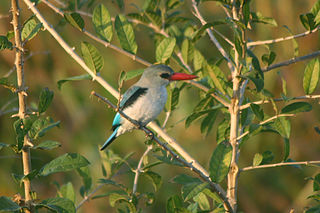 W
WThe mangrove kingfisher is a kingfisher in the genus Halcyon. It is similar in appearance to the woodland kingfisher. It is found along the eastern coastline of Sub-Saharan Africa, living in woodland, along rivers, and in estuaries and mangrove. The International Union for Conservation of Nature (IUCN) has assessed it as being of least concern.
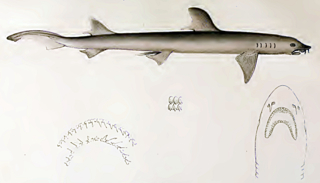 W
WThe barbeled houndshark is a species of ground shark and the only member of the family Leptochariidae. This demersal species is found in the coastal waters of the eastern Atlantic Ocean from Mauritania to Angola, at depths of 10–75 m (33–246 ft). It favors muddy habitats, particularly around river mouths. The barbeled houndshark is characterized by a very slender body, nasal barbels, long furrows at the corners of the mouth, and sexually dimorphic teeth. Its maximum known length is 82 cm (32 in).
 W
WThe lesser woolly bat is a species of vesper bat in the family Vespertilionidae. It is found in Botswana, Central African Republic, Democratic Republic of the Congo, Ivory Coast, Ethiopia, Gabon, Ghana, Guinea, Kenya, Liberia, Malawi, Nigeria, South Africa, Tanzania, Zambia, Zimbabwe and rarely Ethiopia. Its natural habitats are subtropical or tropical moist lowland forests, dry savanna, and moist savanna. Members of this species typically have a dark greyish brown fur with whitish tips scattered throughout.
 W
WThe Madagascan owl, also known as the Madagascar owl or Madagascar long-eared owl, is a medium-sized owl endemic to the island of Madagascar. It is sometimes considered to be conspecific with the long-eared owl.
 W
WThe Malagasy mouse-eared bat is a species of bat in the family Vespertilionidae that is endemic to Madagascar.
 W
WThe eastern green mamba is a highly venomous snake species of the mamba genus Dendroaspis native to the coastal regions of southern East Africa. Described by Scottish surgeon and zoologist Andrew Smith in 1849, it has a slender build with bright green upperparts and yellow-green underparts. The adult female averages around 2 metres in length, and the male is slightly smaller.
 W
WMochlus sundevallii, also known commonly as Peters' eyelid skink, Peters' writhing skink, and Sundevall's writhing skink, is a species of lizard in the family Scincidae. The species is endemic to Africa.
 W
WThe Namaqua chameleon is a ground-living lizard found in the western desert regions of Namibia, South Africa and southern Angola.
 W
WNucras tessellata, the western or striped sandveld lizard, tiger lizard, or striped or banded sand lizard, is native to the west coast of Southern Africa. It is found in the Western Cape, Tankwa Karoo National Park, Richtersveld, Botswana, Kalahari Gemsbok National Park and Namibia. Although preferring arid, sandy areas they also stray into fynbos and mountain grassland. Members of the genus Nucras have a cylindrical body and an extremely long tail. They are secretive and not often seen.
 W
WThe klipspringer is a small antelope found in eastern and southern Africa. The sole member of its genus, the klipspringer was first described by German zoologist Eberhard August Wilhelm von Zimmermann in 1783. The klipspringer is a small, sturdy antelope; it reaches 43–60 centimetres at the shoulder and weighs from 8 to 18 kilograms. The coat of the klipspringer, yellowish gray to reddish brown, acts as an efficient camouflage in its rocky habitat. Unlike most other antelopes, the klipspringer has a thick and coarse coat with hollow, brittle hairs. The horns, short and spiky, typically measure 7.5–9 cm.
 W
WPanaspis wahlbergi, also known commonly as the Angolan snake-eyed skink, the savannah lidless skink, and Wahlberg's snake-eyed skink, is a species of lizard in the family Scincidae. The species is indigenous to Sub-Saharan Africa.
 W
WPentaceros richardsoni, the pelagic armourhead, Richardson's boarfish or southern boarfish, is a species of marine ray-finned fish, an armourhead from the family Pentacerotidae. It has a wide distribution in the oceans of the southern hemisphere. It is commercially important as a food fish.
 W
WThe dassie rat is an African rodent found among rocky outcroppings. It is the only living member of its genus, Petromus, and family, Petromuridae. The name "dassie" means "hyrax" in Afrikaans, and the two animals are found in similar habitats. Petromus means "rock mouse" and dassie rats are one of many rodents sometimes called rock rats. The family and genus names are sometimes misspelled as Petromyidae and Petromys.
 W
WPhilothamnus natalensis, commonly known as the Natal green snake, is a species of snakes in the family Colubridae. The species is found in South Africa, Eswatini, Mozambique and Zimbabwe. Philothamnus occidentalis was previously considered a subspecies.
 W
WPlatysaurus is a genus of lizards, commonly known as flat lizards for their flat backs, in the family Cordylidae.
 W
WPoroderma is a genus of catsharks, and part of the family Scyliorhinidae. The color of these sharks are usually grey with dark stripes. They are found in South Africa and are nocturnal. They live preferably in shore areas, close to the bottom, to depths of 100 m. They prefer small caves and crevices. Their diet usually consists of crustaceans, but they also feed on small fish. Their average size is between 60 and 80 cm, with a maximum total length of about 100 cm. Their birth size is about 15 cm. They are harmless to humans.
 W
WPoyntonophrynus vertebralis is a species of toad in the family Bufonidae. It is found in South Africa, Lesotho, and possibly Botswana and southeastern Zimbabwe. It has many common names: pigmy toad, pygmy toad, flat toad, African dwarf toad, and southern pygmy toad.
 W
WPseudocordylus is a genus of small to large girdled lizards from South Africa, commonly known as crag lizards. Six species of Pseudocordylus are known; they are distinguished from girdled lizards of the genus Cordylus by the presence of granular scales on the back instead of osteoderms. However, recent molecular data places Pseudocordylus within Cordylus.
 W
WThe pygmy falcon or African pygmy falcon, is a bird species native to eastern and southern Africa. It is the smallest raptor on the continent. As a small falcon, only 19 to 20 cm long, it preys on insects, small reptiles, and small mammals.
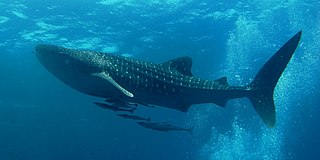 W
WThe whale shark is a slow-moving, filter-feeding carpet shark and the largest known extant fish species. The largest confirmed individual had a length of 18.8 m (62 ft). The whale shark holds many records for size in the animal kingdom, most notably being by far the largest living nonmammalian vertebrate. It is the sole member of the genus Rhincodon and the only extant member of the family Rhincodontidae, which belongs to the subclass Elasmobranchii in the class Chondrichthyes. Before 1984 it was classified as Rhiniodon into Rhinodontidae.
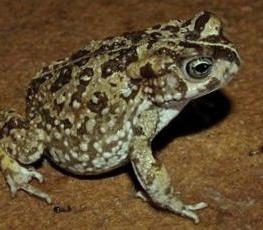 W
WThe sand toad, Cape sand toad, common Cape toad, or narrow-headed toad is a species of toad in the family Bufonidae. It is endemic to South Africa and found in southwestern and southern part of Western Cape Province to extreme southwestern Eastern Cape Province, from Nieuwoudtville in the west to Humansdorp in the east, along the coastal flats and Cape Fold Mountains from the sea level to 1,500 m (4,900 ft) asl.
 W
WThe African red toad, or African split-skin toad, is a species of toad in the family Bufonidae. It is the only species of the monotypic genus Schismaderma. It is found in Angola, Botswana, Democratic Republic of the Congo, Kenya, Malawi, Mozambique, Namibia, South Africa, Swaziland, Tanzania, Zambia, Zimbabwe, and possibly Lesotho. Its natural habitats are dry savanna, moist savanna, subtropical or tropical dry shrubland, subtropical or tropical moist shrubland, subtropical or tropical dry lowland grassland, freshwater marshes, intermittent freshwater marshes, arable land, pastureland, urban areas, water storage areas, ponds, canals and ditches, and man-made karsts.
 W
WStrongylopus fasciatus, also known as the striped stream frog, striped grass frog, striped rana, striped long-toed frog or long-toed grass frog, is a species of frog in the family Pyxicephalidae. It is endemic to southern Africa.
 W
WThe swamp musk shrew, or musk shrew, is a species of mammal in the family Soricidae. It occurs in Angola, Botswana, Democratic Republic of the Congo, Mozambique, Namibia, South Africa, Eswatini, Zambia and Zimbabwe. Its natural habitat is swamps, and it is a common species in suitable habitats, with the International Union for Conservation of Nature listing it as being of "least concern".
 W
WTelescopus semiannulatus, commonly known as the common tiger snake, tiger cat snake, or eastern tiger snake is a species of rear-fanged colubrid snake. It is widespread in central, eastern, and southern Africa.
 W
WThe twig snakes, also commonly known as bird snakes or vine snakes, are a genus of rear-fanged venomous snakes in the family Colubridae. The genus is native to Africa. All species in the genus have a slender and elongated profile, a long tail, a narrow head, and a pointed snout. The eye of all species has a horizontal pupil, shaped like a keyhole, which gives twig snakes binocular vision. Twig snakes are greyish-brown with faint light and dark markings. When threatened, they inflate the throat to display bold black markings between the scales. Twig snakes are considered to be very dangerous because the venom is hemotoxic, affecting the blood clotting mechanism and causing uncontrolled bleeding. Bites by twig snakes have caused death in humans; famous herpetologist Robert Mertens died after being bitten by his pet Savanna vine snake.
 W
WTilapia is a genus of cichlid fishes endemic to freshwater habitats in Southern Africa. In the past this was a very large genus including all species with the common name tilapia, but today the vast majority are placed in other genera.
 W
WTilapia sparrmanii, the banded tilapia, or vlei kurper, is a widespread and adaptable cichlid fish that is found in warmer freshwater habitats of southern Africa. They prefer water with ample plant cover, and occur naturally as far north as DR Congo and Tanzania. They have been introduced locally in the northern hemisphere. Younger banded tilapia feed on crustaceans and insect larvae, while the adults feed on terrestrial and aquatic plants and other debris. They undertake local migrations and may shoal before and during spawning time. They guard their own eggs, and although they may move eggs or fry in the mouth, they are not known to be actual mouthbrooders like several other tilapia species. This species can reach a length of 23.5 centimetres (9.3 in) TL and is an important foodfish.
 W
WTrachylepis punctatissima, commonly called the montane speckled skink or speckled rock skink, is a lizard in the skink family (Scincidae) which is widespread in southern Africa. The common and adaptable species occurs in a variety of habitat types at middle to high altitudes. It was for a time treated as a southern race of the African striped skink, T. striata.
 W
WVandijkophrynus, also known as Van Dijk's toads, are a small genus of true toads, family Bufonidae. They are native to Southern Africa. The name commemorates Eddie Van Dijk, a South African herpetologist.
 W
WThe sand toad, Cape sand toad, common Cape toad, or narrow-headed toad is a species of toad in the family Bufonidae. It is endemic to South Africa and found in southwestern and southern part of Western Cape Province to extreme southwestern Eastern Cape Province, from Nieuwoudtville in the west to Humansdorp in the east, along the coastal flats and Cape Fold Mountains from the sea level to 1,500 m (4,900 ft) asl.
 W
WThe Karoo toad, Gariep toad, or mountain toad is a species of toad in the family Bufonidae found in southern Namibia, much of South Africa, Lesotho, and Eswatini. It is an abundant species that occurs in many types habitat: fynbos heathland, succulent karoo, thickets, grassland, and Nama Karoo. Breeding takes place in permanent and temporary waterbodies. There are no significant threats to this adaptable species.
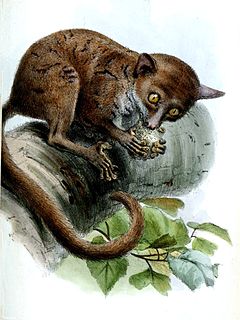 W
WThe western dwarf galagos are a group of three species of strepsirrhine primates, native to western and central Africa. They are classified in the genus Galagoides of the family Galagidae. The eastern dwarf galagos have been moved to their own genus, Paragalago, based on genetic evidence and differences in vocalization. The two genera are not sister taxa and thus may have evolved their small sizes via parallel evolution. They are separated by the East African Rift.